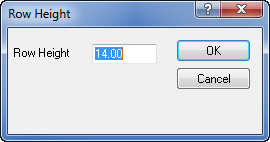 button. Enter the
height for the selected row or cells in the Row
Height dialog. Rows can range from zero to 512 points in height.
A value of zero (0) hides the row.
button. Enter the
height for the selected row or cells in the Row
Height dialog. Rows can range from zero to 512 points in height.
A value of zero (0) hides the row.You can change the Row Height of selected cells by clicking the Format | Row Height command or by using the mouse to size the row. The Excel XLS or SYLK SLK file format must be used to save the row height and numeric format information with the file since ASCII file formats (.CSV, .TXT, .DAT, .BNA, .BLN) do not preserve file format information.
To set the row height or hide rows, select either the entire row or
individual cells within the rows (see Selecting
Worksheet Cells), and click the Format
| Row Height command or
click the  button. Enter the
height for the selected row or cells in the Row
Height dialog. Rows can range from zero to 512 points in height.
A value of zero (0) hides the row.
button. Enter the
height for the selected row or cells in the Row
Height dialog. Rows can range from zero to 512 points in height.
A value of zero (0) hides the row.

Change the row height by selecting rows,
choosing Format
| Row Height, and then
entering a number into the Row
Height dialog.
Row height can also be changed using the mouse. When the cursor is moved
to the line that defines the lower boundary of the row header, the cursor
changes to a line with two arrows  . Press
and hold the left mouse button and move the cursor up or down to change
the height of the row.
. Press
and hold the left mouse button and move the cursor up or down to change
the height of the row.
You can hide a row by moving the cursor up until the next dividing line is reached.
To display hidden rows, press and hold the left mouse button at the bottom of the hidden row and move the cursor down to stretch the row height.
See Also